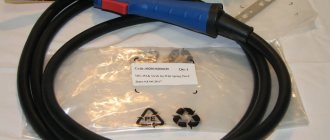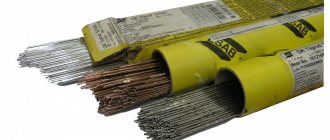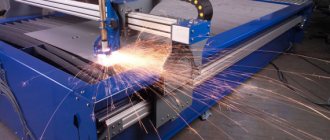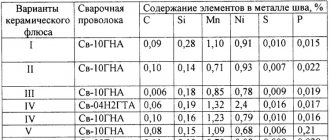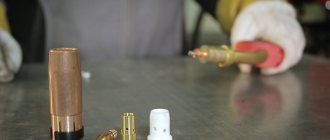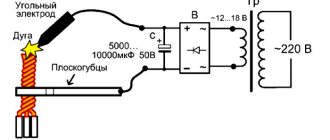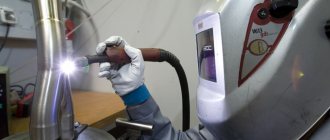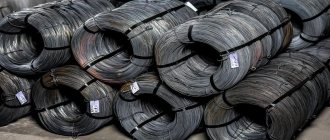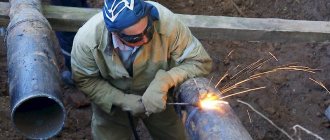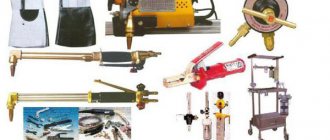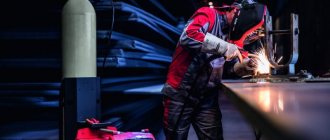Welding wire is the most important consumable material used when welding in manual, automatic or semi-automatic modes. The additive is a metal product wound on a reel.
In most cases, the welding additive is used for the manufacture of flexible electrodes or is used as a filler material, providing a high-quality seam and reliable connection of metal parts.
Semi-automatic welding using filler wire requires the use of a shielding gas atmosphere.
Types of wire for semi-automatic machines
The selection of welding wire for semi-automatic machines should be carried out for a specific type of metal being joined. The use of filler consumables significantly improves the quality of the seam and prevents the formation of pores and irregularities in the joint.
The main advantages of using an additive when performing welding work are presented:
- acceleration of the welding process;
- ease of use in industrial applications;
- a significant reduction in the likelihood of defects due to the lack of additive coating;
- a large selection of consumables, allowing you to select the optimal additive for each specific case;
- low level of slag formation during welding.
Disadvantages of using a filler component in welding:
- the need for constant protection;
- difficulty in storing large skeins;
- difficulty in selecting the optimal diameter of the additive;
- the need to constantly use flux.
Wire grades table.
All types of wire for welding are usually divided into:
- Copper-plated. This type of wire is used for welding carbon and low-alloy steel parts. Copper-plated steel filler components provide high-quality welds and are characterized by a low metal spatter coefficient.
- Powder. Additive components of such grades are made in the form of a hollow tube made of low-carbon steel. Inside the container there are deoxidizers and slag-forming substances, which ensure comfortable use of semi-automatic welding without shielding gas. Flux cored filler wires help to significantly reduce slag formation and reduce weld processing time.
- Solid section. This type of wire differs from ordinary wire in that welding electrodes are made from it.
- Non-copper-plated. Additives of this type are used primarily for working with products made of low-carbon steel.
- Activated. Powder additives used during welding in a carbon dioxide atmosphere.
- Gas welding. To work with carbon and low-carbon grades of steel, it is best to use gas welding filler components.
- Aluminum. One of the few types of wires suitable for welding aluminum parts. When working with aluminum filler, low porosity of welds is observed. Such additives are actively used in the shipbuilding and dairy industries.
- Made from stainless steel. The filler component allows you to weld stainless steel products and prevent corrosion of the resulting weld.
- Flux. This type of filler wire is widely used for joining medium carbon, low carbon and carbon steels. Due to the presence of a built-in flux, such additives can be used when welding without shielding gas.
- Alloyed. One of the best components that allows welding work in any gas mixtures and with any types of metals.
Classification and labeling
Before choosing the type of filler component, you should clearly understand what materials will be welded. There are several groups of wires that contain alloying elements.
This classification includes:
- additives containing a small amount of carbon;
- filler materials containing a small amount of alloying metals;
- high alloy additives.
The marking of welding wire depends, first of all, on the grade of steel being welded and the atmosphere in which the work will be carried out.
Steel filler wire is one of the most popular and in demand.
Filler rods for welding.
In accordance with the state standard, depending on the diameter, welding wire is divided into:
- Diameter from 0.3 to 1.6 millimeters. Copper-plated wire with this cross-section is used when welding metal parts with a semi-automatic welding machine in a protective atmosphere.
- Diameter from 1.6 to 12 millimeters. A similar type of filler material can be used to create welding electrodes.
- Diameter from 2 to 6 millimeters. This type of wire is used during welding with flux.
The marking number of the additive material is necessary to indicate the composition of the additive.
In accordance with the state standard, the wire additive is marked as follows:
- the first numbers are the diameters in millimeters;
- the letters following the numbers are the purpose of the additive;
- the further indicator shows the carbon content in fractions of a percent;
- the fourth block of designations is an indicator of alloying components;
- the fifth block carries information about the use of the additive, for example, the letter E means for the electrode, and the welding additive is indicated by the letter O.
For example, a wire additive, marked as 3SV-08A-0-Sh GOST 2247-70, is deciphered as follows: 3 is a diameter of 3 millimeters, SV is a welding wire, 08A is 0.08% carbon, 0 is a copper-plated additive, Ш is electroslag remelting and GOST 2246-70 is the designation of the state standard to which this consumable material corresponds.
Kinds
Copper welding wire M1. Photo BVB-Alliance
The chemical composition of copper filler wire, which differs significantly from copper-plated wire, should be close to the composition of the copper alloys being welded. Therefore, the number of types corresponds to existing grades of copper and alloys based on it.
- For welding seams, where strength characteristics are not so important, filler material made of technical copper is used. M1 welding wire is one of these materials.
- Welding of copper alloys, where nickel is the main alloying element (constantan, cupronickel and others), is performed using copper-nickel filler wire, such as, for example, alloyed wire MNZh5-1.
- Copper-aluminum filler wire, such as CuAl8 , is used for welding aluminum bronzes.
- Copper-silicon CuSi3 is used for welding copper-silicon, copper-zinc alloys and galvanized steel in an inert argon gas environment.
- Copper-tin filler material ( BrOF6.5-0.15 ) is used for gas-shielded welding of tin-phosphor bronze and other tin bronzes.
- Brass wire and rods made from it ( L63, L60-1 and others) are used in gas welding of brass and surfacing operations to improve the properties of carbon steels.
Chemical composition for welding steel
The steel welding additive guarantees good mechanical properties of the weld. The main grades of wire filler used for welding carbon steels are shown in the table below:
| Filler wire marking | ||
| Protection: nitrogen and helium | Protection: CO2 | |
| 20ХГСА | Sv-15KhMA, Sv-18KhGSa | Sv-08G2S |
| 30ХГСА | Sv-15KhMA, Sv-18KhGSa | Sv-10GSM, Sv-10GSMT, Sv-08Ch2SMA |
| 12ХМ | Sv-08ХМ | Sv-10ХГ2СМА |
| 15ХМ | Sv-08ХМ | Sv-08HNSMA, Sv-08HG2SM |
| 12Х1МФ | Sv-08HMFA | Sv-08KhGSMFA |
| 15Х1МФ | Sv-08ХМ | Sv-08H1M1GSF |
| 15Х5М, 15Х5, 15Х5ВФ | Sv-10Х5М, Sv-08G2S | Sv-08G2S |
According to the state standard, filler wires for welding stainless steel and ordinary steel are divided into:
- carbon, intended for joining products made of low and medium carbon steels;
- alloyed, for welding low-alloy and heat-resistant metals;
- high-alloy, used when working with chromium-nickel, stainless or other alloy steels.
Filler materials for stainless steel are chromium or nickel-containing steels.
The main advantages of specialized welding additives designed for joining stainless steel products are:
- high quality weld;
- homogeneity and absence of pores in the connection;
- corrosion resistance;
- minimum metal spatter coefficient;
- stable burning of the electric arc during operation.
When trying to calculate the additive consumption for a weld, it should be taken into account that the additive for stainless steel has an increased resource.
Consumables used when working with high-alloy or stainless steels are divided into two types:
- powder;
- solid.
Argon welding method.
Powder additives allow welding to be carried out without the use of shielding gases. In the simplest case, the powder additive is a hollow tube with flux inside.
During operation, flux and filler elements form a cloud of gas, which contributes to high-quality weld welding. Such wires can be used in conditions of insufficient space, since a welding machine without a gas cylinder can reach even the most inaccessible places.
Solid wires are ordinary additives intended for welding in shielding gases, for example, Argon or carbon dioxide.
It is worth noting that filler elements used for welding stainless steel are divided into classes:
- normal accuracy;
- increased accuracy with marking P.
The most commonly used types of filler materials for welding stainless steel products are:
- Sv06Х20Н11М3.
- Sv01Х18Н10.
- Sv01Х19Н9.
When decrypting, remember that:
- A stands for nitrogen;
- B – niobium;
- B is tungsten;
- D – copper;
- M – molybdenum;
- C is silicon;
- T – titanium;
- X – chromium;
- N – nickel;
- Yu – aluminum;
- F – vanadium;
- C – zirconium.
Application
The main purpose is to use consumables on semi-automatic machines in an atmosphere of protective gas . In cases where self-shielding wire is used, welding is performed without gas.
Wire is used as a surfacing material if it is necessary to change the geometry of the surface of a part or add additional properties (surface hardness, corrosion resistance, etc.).
Aluminum welding wire ER4043 (1.6 mm; spool 6 kg) ELKRAFT 93614. Photo AllInstruments.ru
Some types serve as blanks for electrodes . The most commonly used is low carbon wire.
Manufacturers of welding wire products
The main brands of welding wire are produced by the following manufacturers:
- SvarMontazhStroy. One of the most famous Russian production facilities, specializing in the production of filler wire of various brands for all types of welding. Modern equipment and the use of European manufacturing technologies allow the company to produce products that meet the highest quality standards.
- LLC Petromet. The enterprise, which belongs to the Leningrad plant, produces wire grades Sv01Х18Н10, Sv-15ХМА and others.
- Weld-Metiz LLC.
- OJSC Volgograd Steel Wire Rope Plant. Stainless steel wire produced by the steel wire rope plant meets state standards and can be used when performing welding work with a semi-automatic device.
- OJSC West Siberian Metallurgical Plant.
Table of types of welding wire.
Filler materials for semiautomatic welding machines produced by these enterprises are divided into 77 varieties. Many manufacturers coat the welding filler wire with copper, which produces a better weld and reduces molten metal droplet spatter.
Purpose of welding wire
Welding wire is intended for the production of coated piece electrodes for manual arc welding (MMA), for the production of rods for argon arc welding with a non-consumable electrode (TIG) and for the actual production of welding wire for semi-automatic and automatic welding (MIG/MAG and SAW).
During the welding process, the welding wire plays the role of an electrode for transmitting welding current to the arc zone (excluding the process of arc welding with a non-consumable electrode) and the role of a filler material for forming a weld to ensure strength characteristics.
How to choose wire?
The welding wire is used during welding. The use of filler material allows you to fill the weld seam formed during the connection of metal products.
In other words, the use of filler wire makes it possible to compensate for metal losses resulting from spattering. Experts note that in addition to wire, filler materials in the form of rods and tapes can be used.
Content of components in welding wire.
There are two main rules when choosing welding wire:
- The material from which the additive is made must have the same composition as the products being welded. Before moving on to choosing an additive material, you should study the composition of the products and select an additive with the most similar composition. Harmful materials that cause increased consumption of welding wire are sulfur and phosphorus.
- The melting point of the filler material should be slightly lower than that of the products being welded. Welding work performed using filler wire with a melting point higher than that of the metal of the part can lead to burnout of the product. Before joining the metal, it is necessary to select a wire that melts evenly. This approach will allow you to obtain a durable seam without slagging or cavities.
The best grade of wire must meet the following requirements:
- the diameter of the filler should be similar to the thickness of the metal being welded;
- the wire additive must not contain rust, paint or any other contaminants that affect the chemical composition;
- the additive used in welding must be adjusted evenly;
- the seam obtained as a result of welding work should not contain scale, slag, cracks and pores.
It is necessary to select an additive component depending on the metal of the products being connected.
Filler wire for steel welding
To connect steel parts, it is best to use a copper-plated additive, for example, grade SV-08G2S. This option is ideal for welding work on pipelines, boilers and containers under high pressure.
In addition, this brand of filler material is excellent for working with thin sheet steel. Several more optimal types of filler components for welding steel structures are shown in the table:
| Wire grade | Shielding gas used | Use temperature | Special marks |
| Sv-08GS, Sv-08GSMT | Carbon dioxide | -40 to +475 | None |
| Sv-08G2SNTYUR | Carbon dioxide | -70 to +475 | Does not require further seam processing |
| Sv-08G2S | Argon, Argon + Carbon dioxide | -70 to +475 | Does not require further seam processing |
| Sv-08GSMT | Carbon dioxide, Argon or mixture | -40 to +350 | For connecting products made of steel type 15G2SF |
| Sv-10X5M | Carbon dioxide, Argon or mixture | 0 to +600 | The work is carried out with preheating of the products to +300 degrees and subsequent tempering at 750 degrees for three hours. |
| SV-04Х19Н11М3 | Argon or a mixture of Argon + Carbon dioxide | -70 to +350 | For products that do not require resistance to intergranular corrosion. |
| Sv-01Х17Н14М | Argon or a mixture of Argon + Carbon dioxide | -70 to +350 | Suitable for structures that require increased resistance to intergranular corrosion. |
Almost all of the above wires have a similar consumption when welding with semi-automatic welding. It is necessary to select a filler component for connecting steel products based on the requirements for the resulting weld.
Wire for welding aluminum
For welding aluminum products, a wire filler is used, consisting of either pure aluminum or aluminum with the addition of magnesium and silicon.
In most cases, additives used to join aluminum parts are divided into:
- pure aluminum, with an Al content of 99%;
- aluminum-silicon, with a ratio of 95% and 5%, respectively;
- aluminum-magnesium, with a metal ratio of 94% and 6%, respectively.
The main brands of filler components used when joining aluminum are shown in the table below:
| Wire grade | Shielding gas used | Domestic analogue |
| OK Autrod 1070 The additive is used for welding pure aluminum and ductile alloys. Characterized by excellent resistance to chemical attack. | Argon | St.-A97, St.-A85, St.-Amts. |
| OK Autrod 4043 Widely used for welding alloys such as AD31, AD33, AD35 | Argon | St.-AK5, St.-AK6 |
| OK Autrod 1450 Chemical and environmental resistant wire provides a fine-grained weld. | Argon | St.-1201 |
| OK Autrod 5356 This grade of material is regularly used for welding metal structural profiles made of aluminum and manganese. | Argon | St.-Amg 3 |
| OK Autrod 5183 This type of filler wire is used for welding non-hardenable aluminum alloys. | Argon | St.-AMg 5 |
Filler material for joining stainless steel products
When welding stainless steel, the use of shielding gas is mandatory. As a rule, the additive components include silicon and carbon. The silicon component of the additive makes it possible to obtain a high-quality and durable weld; carbon is necessary to prevent the formation of intergranular corrosion.
Some brands of stainless steel welding additives may contain chromium and nickel. These elements make the filler material more durable and resistant to corrosion.
The main brands of wire for connecting stainless steel products are:
| Wire grade | Shielding gas used | Domestic analogue | Chemical composition |
| OK Autrod 347 Si Used for joining stainless steel grades 08Х18Н10, 12Х18Н9Т, 08Х18Н10Т and similar. Thanks to niobium and silicon, the filler component ensures excellent weld quality and prevents the formation of intergranular corrosion. | Argon | St.-06Х21Н7БТ, St.-06Х19Н9Т, St.-01Х18Н10, St.-01Х19Н9. | Carbon <0.08, Silicon 0.8, Manganese 1.7, Chromium 20.0, Nickel 10.0, Niobium 0.6 |
| OK Autrod 308LSi Filler wire is widely used for welding austenitic stainless steels. Widely used in food, petrochemical and other industries. | Argon | St.-06Х19Н9Т, St.-01Х18Н10, St.-01Х19Н9. | Carbon <0.03, Silicon 0.8, Manganese 1.7, Chromium 20.0, Nickel 10.0 |
| OK Autrod 318 Si Wire for welding steels containing chromium, nickel and molybdenum. Thanks to niobium, high resistance against intercrystalline corrosion is ensured. Due to the presence of silicon in the composition, the additive ensures high quality welds. | Argon | St.-08Х19Н10М3Б, St.-06Х20Н11М3ТБ | Carbon <0.08, Silicon 0.8, Manganese 1.7, Chromium 19.0, Nickel 12.5, Niobium 0.6, Molybdenum 2.7 |
Copper welding wire
Copper products are common in industry due to the incredible properties of this metal to effectively resist corrosion even in the most unfavorable environments.
Due to the fact that the seams obtained as a result of welding operations must have good physical properties, including thermal conductivity, electrical conductivity, corrosion resistance and density, increased demands are placed on the wire filler.
The most optimal types of filler material for copper welding are:
| Brand and description of wire | Shielding gas used |
| OK Autrod 19.12 Wire of this brand is actively used for welding copper products and parts made of low-alloy copper alloys. | Argon |
| OK Autrod 19.30 Used when joining products made of bronze or low-alloy copper. This type of filler material is widely used in the automotive industry, as it contributes to the formation of a high-quality seam when connecting copper to cast iron. | Argon or Argon + 1% oxygen |
| OK Autrod 19.40 Used for welding castings and rolled aluminum bronzes. Can also be used to connect copper pipes. | Argon |
Most copper welding filler materials are supplied wound on plastic cartridges. Standard wire thickness is 0.6, 08 or 1 millimeter. When welding copper products, a flux containing borax, sodium chloride and boric acid should be used.
Connecting parts made of cast iron and nickel
Welding of nickel products is carried out using filler wire containing manganese, silicon, magnesium and titanium. The manganese component promotes the binding of sulfur, silicon is necessary to increase the fluidity of the metal, magnesium is needed for the final binding of sulfur particles.
The diameter of the filler wire for welding nickel products should be equal to half the thickness of the part.
To weld cast iron parts, special attention must be paid to the choice of additive. The fact is that the use of conventional copper-plated additives when welding cast iron leads to the appearance of cracks in the weld. That is why it is recommended to use filler elements containing non-ferrous alloys to connect cast iron products.
The optimal additives for welding products made of cast iron and nickel are shown in the table:
| Brand and description of wire | Shielding gas used |
| OK Autrod 19.82 Nickel-based filler wire is ideal for joining nickel, high-alloy steel and cast iron. In most cases, it is used for welding tanks, pipelines and structures in the chemical industry. | Argon |
| OK Autrod 19.85 Used when welding parts made of nickel or heat-resistant steels. Excellent for joining products made of dissimilar metals. | Argon |
| OK Autrod 15.66 Well suited for welding cast iron parts. It is used for welding work related to pumps, shut-off valves and heavy sections of machines. | Argon or Argon +2% oxygen |
Flux filler wire
Flux-cored filler wire is widely used for welding low-alloy and carbon steels.
Welding wire material.
The key advantages of powder additive are:
- ability to follow the arc;
- ideal weld composition;
- welding work can be carried out in any position;
- the equipment can be used even in the most inaccessible places, due to the absence of the need for equipment for supplying gas and flux;
- counteraction to the mechanical pressure of welding beads, thanks to the use of a special lubricant in the additive.
Depending on the type of filler, powder additive components are divided into:
- rutile for welding medium-carbon steels;
- rutile-fluorite, used in the welding of low-alloy steels;
- fluorite-carbonate, used in welding low-carbon and low-alloy steel structures;
- fluorite, suitable for welding low-alloy steel products;
- organic rutile, used in welding low-carbon steels.
Experienced welders recommend using Esab universal cored wire, which provides high mechanical properties of the weld between most metals. This additive is not a powder additive, however, it contains flux inside it, which ensures good welding quality.
Distinctive features, advantages and disadvantages
Aluminum-copper welding wire Bercoweld A8 (CuAl8), 1mm, 5kg. Photo Welding Technologies
In its normal state, copper and its alloys do not interact with the environment. When heated, it begins to react intensively with oxygen, hydrogen, sulfur, phosphorus and other elements.
When the weld seam cools, copper oxides initiate the formation of cracks. To reduce the influence of oxygen, deoxidizing elements are added to the filler wire, and the welding zone is protected with inert gases or nitrogen.
Hydrogen is one of the main causes of weld porosity . Copper, having high thermal conductivity, quickly crystallizes after welding. Hydrogen, which has good solubility in molten copper, does not have time to evaporate and pores form.
A peculiarity of brass welding is associated with zinc burnout. The melting point of zinc is lower than that of the base metal, which leads to its evaporation. Technological techniques can reduce this process.
Please note! Shielding gases and calcination of the filler material reduce the negative effects of hydrogen.
